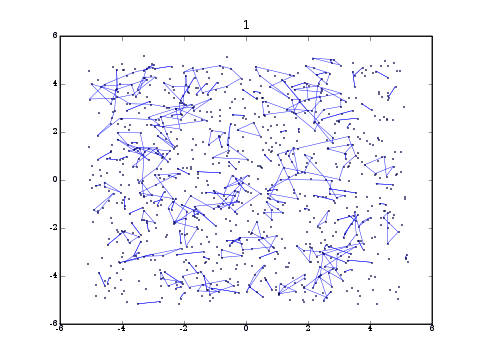|
John Kerl
Graduate student Department of Mathematics University of Arizona http://math.arizona.edu/~kerl E-mail: kerl at math dot arizona dot edu |

|

|
My advisor, Daniel Ueltschi, and I, drawing from the work of Ueltschi, Volker Betz, Daniel Gandolfo, and Jean Ruiz, are studying the effects of interparticle interactions on the critical temperature of Bose-Einstein condensation. This project lies at the crossroads of probability theory, quantum statistical mechanics, functional theory, and numerical methods.
Bose-Einstein condensation is the macroscopic occupation of a lowest-energy quantum state by a system of bosons. The effect was theoretically predicted in the mid 1920s, but it occurs at such a low temperature — at the nanokelvin scale! — that it received relatively little attention. Only in 1995 were Bose-Einstein condensates produced in the laboratory by E. Cornell and C. Wiemann, using sophisticated cooling techniques. They, along with W. Ketterle, were awarded the 2001 Nobel Prize for this work. BECs have now enjoyed a resurgence of interest by theorists as well as experimentalists. Their practical applications at this point might be compared to electromagnetism in the mid 1800s: they contain unknown possibilities, but it is certain that there is new physics to be discovered.
Bose and Einstein predicted a critical temperature for the so-called ideal Bose gas: namely, a system of non-interacting bosons. It is a long-standing question to discover the effects of interbosonic interactions on the critical temperature. Indeed, the main goal of our project is to quantify this dependence precisely for non-ideal Bose gases in the small-scattering-length regime.
To do this, we are examining models of spatial permutations. One applies Feynman’s approach to Bose-Einstein condensation, considering random permutations of points with weights which discourage long permutation jumps. Feynman’s claim is that BEC occurs if and only if there are infinite cycles. The central point of this approach is that the system energy has been recast in terms of permutations, which are amenable to analysis and simulation.
In the animation at the top of this page, there are 103 points uniformly distributed in a 3-dimensional box. There are no interactions and the temperature is sub-critical. Lines between points indicate permutation cycles. Twenty permutations are displayed.